Honestly, who hasn't been there? You're driving a complex construction project, things seem to be going well, and then out of nowhere—bam!—a financial hit you didn't see coming. A cost overrun, a material delay that balloons into a budget disaster, or a subcontractor dispute that just ties everything up. For construction CEOs and owners, these aren't just minor bumps; they're the kinds of nightmares that truly keep you up at night.
Here’s the thing, though: most of these financial risks don't just magically appear. They start small, often hidden deep within the daily grind of the job site, buried in some spreadsheet, or lost in a never-ending email chain. They tend to fester in the dark, you know? The most powerful tool you have to prevent them isn't necessarily a bigger contingency fund; it’s something much simpler and more fundamental: complete, undeniable visibility.
Think about your project like navigating a long road through a dense fog. You can’t exactly avoid the potholes if you can’t see them, right? Financial risk works pretty much the same way. Without a crystal-clear view of every single cost, every progress update, and every potential hiccup, you're essentially just hoping for the best. And hope, let's be real, is hardly a strategy when serious money is on the line.
Essential Insights for Financial Clarity
- Real-time data access is paramount for proactive risk management, allowing quick adjustments.
- Integrated platforms create a single source of truth, minimizing errors and fostering collaboration.
- Predictive forecasting, driven by current data, transforms decision-making from reactive to strategic.
The Steep Price of Operating in the Dark
Why not seeing everything can really hurt your wallet.
It’s no secret that the construction industry operates on notoriously tight margins. Studies have shown that a significant percentage of projects don't even meet stakeholder satisfaction. Why do you think that is? Often, it’s because teams operate in silos; information gets stuck, trapped in individual departments. The folks in the field don’t always know what the office just budgeted for, and management might not spot a critical supply chain snag until it’s already too late to do anything about it.
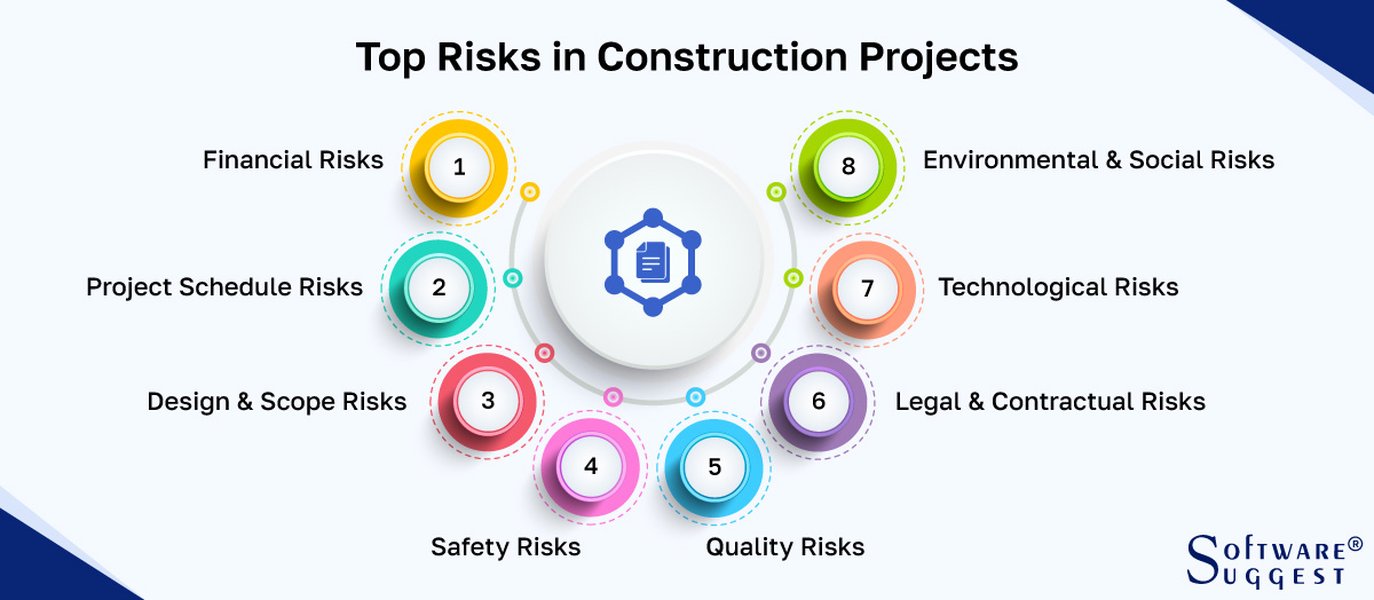
Understanding common risks helps in prioritizing visibility efforts.
This widespread lack of transparency, honestly, leads to communication breakdowns, pretty messy process orientation, and a whole lot of wasted money. You might have a general idea of your budget, sure, but without real-time insight, you’re essentially managing your project by looking in the rearview mirror. You’re constantly reacting to problems rather than getting ahead of them and preventing them from happening in the first place.
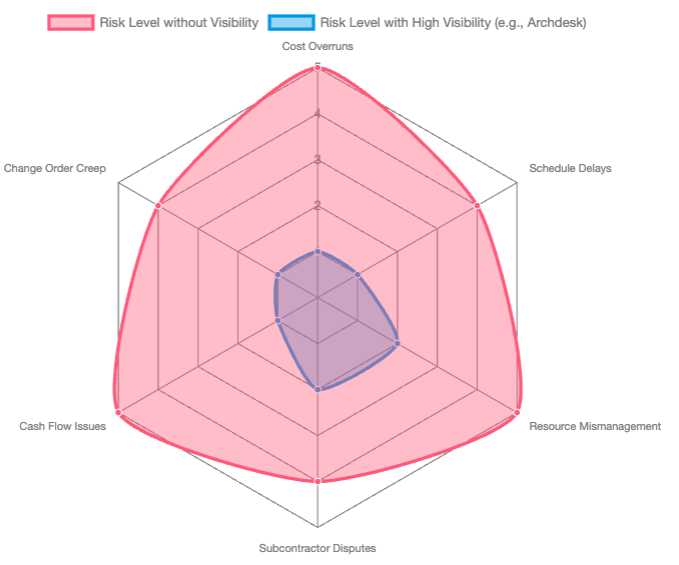
This radar chart illustrates the perceived difference in financial risk levels for various project aspects, with and without robust visibility tools. The "Risk Level without Visibility" dataset shows higher scores across the board, particularly for common pain points like cost overruns, schedule delays, and cash flow issues. In contrast, "Risk Level with High Visibility" demonstrates significantly reduced scores, emphasizing how comprehensive data access and integrated management can dramatically mitigate these risks, allowing construction leaders to operate with greater confidence and control. The visual comparison clearly highlights the strategic advantage of investing in advanced visibility solutions.
Shining a Spotlight: How Visibility Catches Problems Early
Anticipation, control, and building trust are your new best friends.
So, how does truly pulling back the curtain on your operations actually reduce financial risk? It boils down to three really important things: anticipation, control, and trust. Let's break them down a bit.
Anticipation: Seeing the Snowball Before it Becomes an Avalanche
First off, anticipation. Imagine having a platform that provides real-time dashboards – like what you get with Archdesk. You’re not just getting historical data; you’re getting a live look at the health of your project. You can see if that concrete pour is behind schedule this Tuesday, not at the end of the month when it’s already messed up the roofing crew’s timeline. This kind of immediate insight lets you adjust resources on the fly, negotiate with suppliers ahead of time, and cleverly avoid those brutal rush charges. It’s all about spotting the small snowball of an issue before it tumbles down the hill and becomes a full-blown avalanche.
Control: Commanding Your Cash Flow
Next up, control. Financial risk management, at its core, is all about identifying, assessing, and then mitigating potential issues. Clear communication and well-defined contracts are absolutely key here. When all your documents, change orders, and cost codes are living in one centralized system, you pretty much eliminate those version control nightmares. Everyone works from the same single source of truth. This means fewer disputes, cleaner payment applications, and a much, much stronger grip on your overall cash flow. You’re not just tracking expenses; you’re actively commanding them.
Trust: A Shared Mission, Not Just a Chore
And finally, trust. This one, honestly, often gets overlooked, but it's vital. When your entire team—from the project manager all the way down to the foreman—has access to the same clear, accurate data, it builds a powerful sense of accountability. They can literally see how their daily work impacts the budget, how their actions contribute to the bigger picture. It transforms financial management from being just a top-down chore into a shared mission. And that kind of team alignment? Priceless.
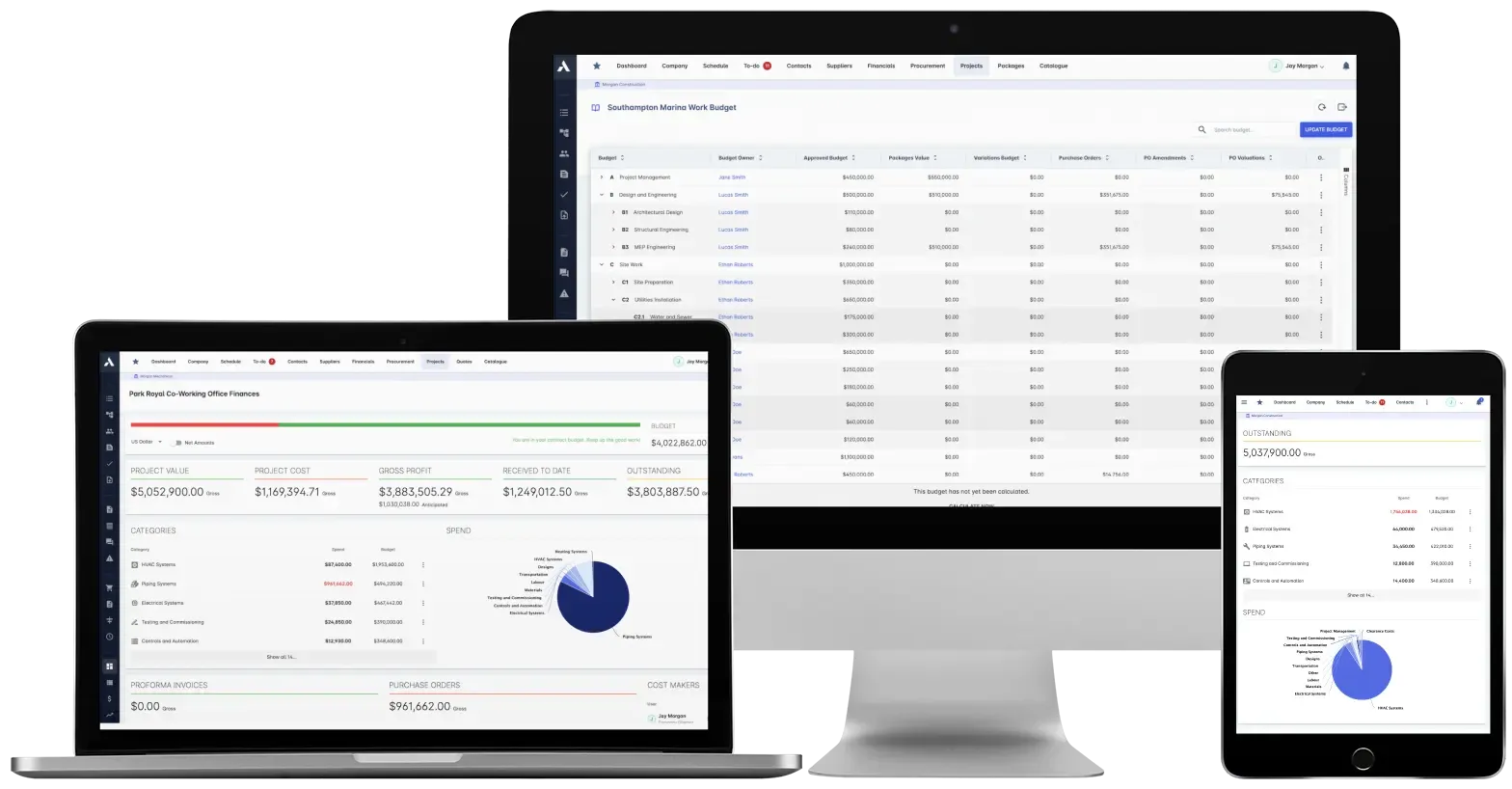
An example of a construction monitoring dashboard, highlighting key performance indicators.
Beyond the Buzzwords: Practical Visibility for the Real World
It’s not just about fancy software; it’s about making life easier.
This isn't just some fancy software talk, you know? This is about practicality. Sure, tools like Procore or Autodesk Construction Cloud talk a lot about connectivity. But true visibility isn’t just about having the software; it’s about how seamlessly it fits into the actual rhythm of your work. Does it make things simpler, or just add another layer of administrative burden?
A system that’s clunky or difficult to use often creates its own set of risks. Data gets entered wrong, people avoid using it, and before you know it, you’re back to square one, managing in the dark. The real goal is a system that feels natural, that simplifies the entire process of capturing critical data from the field so that managers can actually use it effectively. It should make life easier, not add more headaches.
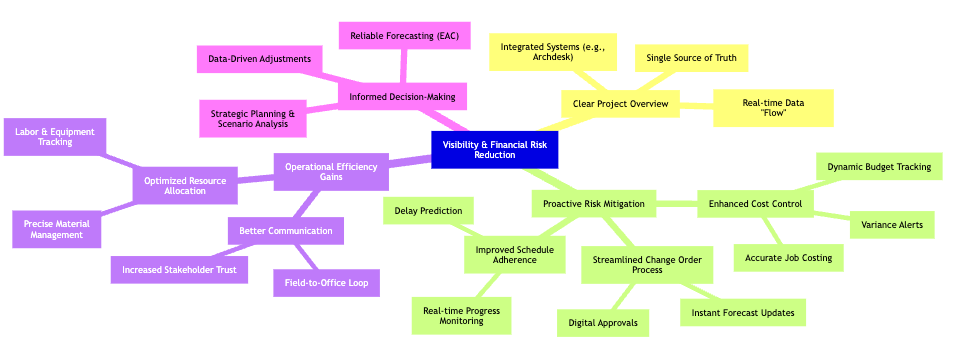
A mindmap illustrating the interconnected aspects of visibility and its impact on reducing financial risk in complex construction projects. It highlights how clarity in various operational areas, driven by tools like Archdesk, directly leads to better risk mitigation, increased efficiency, and more informed decision-making.
The Silent Leaks: Where Money Disappears Without Visibility
Understanding where your profits can quietly slip away.
Where does money actually leak out when you lack proper visibility? It’s often in places you might not immediately consider. Little drips here and there can become a flood.
Labor Drift: Unseen Overtime and Idle Hands
Think about labor drift: those unapproved overtime hours or idle crews you don't even realize are racking up costs. While tools like RedTeam and Raken help track hours, if that time tracking doesn’t feed into job costing quickly, the variance just hides until it’s too late. You only see the damage when the payroll hits, not when you could have done something about it.
Materials Limbo: Double Orders and Rush Charges
Then there's materials limbo. Poor supply chain visibility almost guarantees double orders, or worse, expensive rushed freight to compensate for items you thought you had. Research in industrial construction constantly shows that supply chain visibility gaps push late installations and lead to costly rework. It’s like throwing money at a problem you created because you couldn't see clearly.
Change Order Creep: Margin Erosion with Receipts
And let's not forget change order creep: changes approved in an email thread but completely missed in the actual budget. That, my friend, is margin erosion with receipts. It’s a silent killer for your profits. Archdesk tackles this by baking change order workflows right into cost control, so budgets and forecasts automatically adjust with approvals, not weeks later after the damage is done.
Pay Application Blind Spots: Cash Flow Lockups
Lastly, pay application blind spots. Mismatched quantities, late approvals, and disputes can easily lock up significant cash flow, straining your financial health. This table illustrates some common financial risks and how visibility helps manage them:
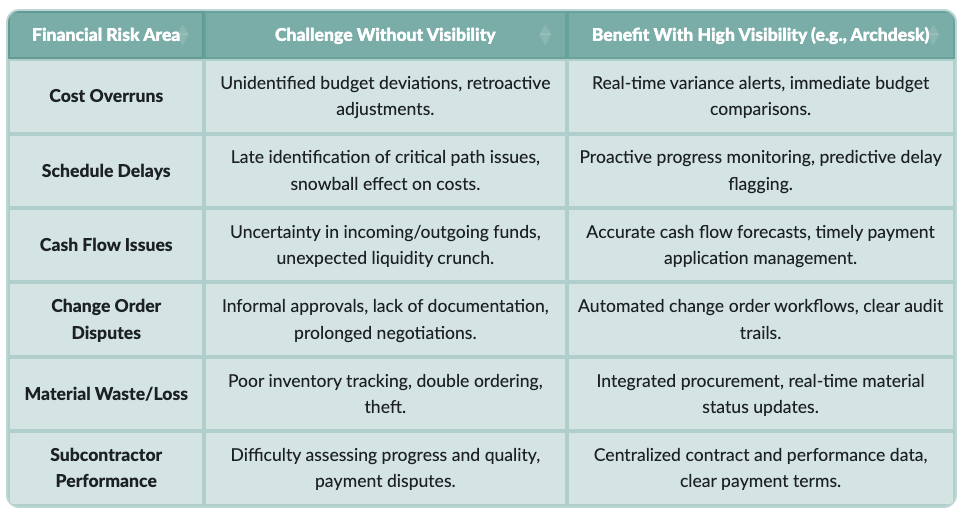
Archdesk: Making the Invisible, Visible
A focused approach for construction leaders who value clarity.
The bottom line, really, is this: you can’t manage what you can’t measure, and you certainly can’t measure what you can’t see. For construction leaders, investing in true project visibility isn’t just a good idea; it’s one of the smartest financial decisions you can possibly make. It shifts your role from constantly being a firefighter to truly being a strategist, guiding your projects with confidence.
Tools like Archdesk are built to streamline these complex processes. They let you create detailed budgets, predict job costs with greater accuracy, and handle all your financial activities from one central, coherent platform. This way, you don't have to worry about critical data getting lost or miscommunicated between different, disconnected systems. Archdesk helps connect the office and the field, giving everyone real-time updates and helping to make faster, more informed decisions.

Team members reviewing blueprints, a critical step where early visibility can prevent later financial issues.
It’s pretty comprehensive, covering everything from managing labor and assets to handling intricate contracts and even those pesky change orders. And because it integrates with your existing accounting systems, financial oversight becomes much, much simpler. You know what? This kind of confidence is the ultimate competitive advantage in construction.
Key Elements of a Truly Visible Project
What a clear picture really entails.
So, what does visibility truly mean in practice? It's more than just having a dashboard up on a screen; it's about deep, actionable insight.
One Source of Truth
First, it means having one single source of truth for your project’s scope, schedule, costs, and all documents. No more hunting through different folders or asking multiple people for the "latest" version. Everyone's operating from the same playbook.
Field Data, Fast to Finance
Then, there's field data that lands directly into cost codes on the very same day, not next month. The field is your early warning system, remember? Daily logs, photos, and quantities absolutely must feed into your job cost system in near real-time. While tools like Procore or Autodesk can capture this information almost well, if your finance team then has to rekey that data into an ERP, you lose that crucial thread. Archdesk closes that loop by tying site entries straight to cost codes, budgets, and WIP, meaning fewer handoffs and significantly fewer surprises.
Forecasting You Can Actually Trust
Finally, it's about forecasts that update the moment reality changes, not long after the damage is done. Executives don't just need another pretty chart; they need believable EAC (Estimate At Completion). That means actuals posted quickly, pending changes reflected immediately, and risks quantified with real notes, not just guesses. Archdesk builds EAC from the same ledger that runs your budgets, change orders, and commitments. So, the number you see is the number your finance team will actually book.
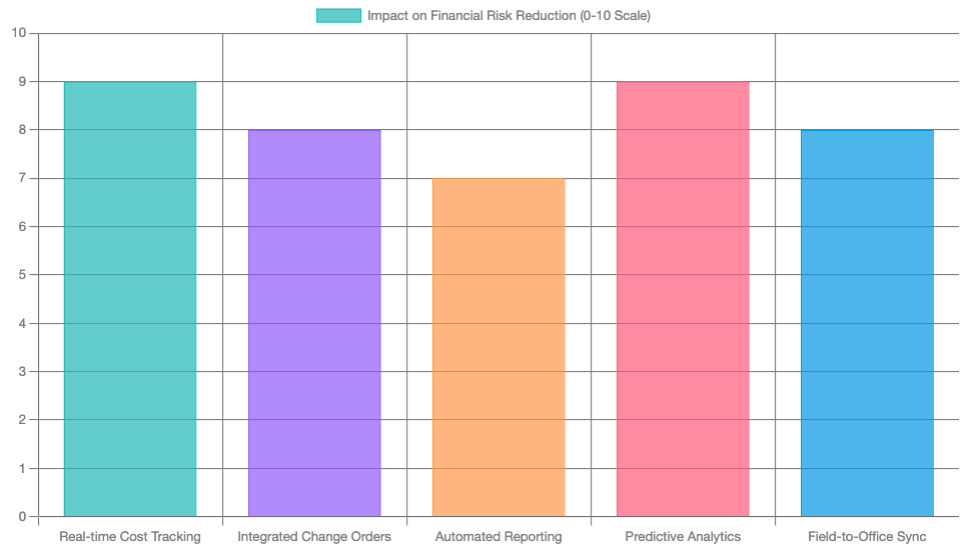
This bar chart evaluates the perceived impact of various visibility features on financial risk reduction, scored on a scale from 0 to 10. "Real-time Cost Tracking" and "Predictive Analytics" show the highest impact, emphasizing their crucial role in proactive financial management. "Integrated Change Orders" and "Field-to-Office Sync" also score highly, highlighting the importance of seamless data flow and process integration. "Automated Reporting" provides a solid foundation for informed decision-making. This chart underscores that a multi-faceted approach to visibility, incorporating these key features, is essential for robust financial risk mitigation.
Quick Wins: Ways to Boost Visibility Today
Small changes, big impact on your financial picture.
You might be thinking, "Where do I even start?" Here are a few quick wins you can implement right away to boost your financial visibility:
- Lock time tracking to cost codes: Make sure every hour worked is tied to a specific cost code and type. Reject entries that don't have one.
- Standardize change order workflows: Route every single change event through the same, formalized workflow. No more "email approvals" that get lost in the shuffle.
- Track critical materials diligently: Keep tabs on four key statuses for essential materials: needed, ordered, shipped, and on site. Connect these statuses directly to your schedule dates.
- Publish a weekly "WIP-lite" report: A simple one-page summary of billed, earned, over or under bill, and your cash exposure. It's a small habit with big foresight.
- Maintain a robust risk log: Keep a log that quantifies risks in dollars and likelihood.
It's interesting to note how regional nuances play a role here too. In North America, the long lead times for electrical gear are a constant concern. Europe often deals with energy cost swings and incredibly strict documentation requirements. Meanwhile, projects in the GCC push aggressive schedules with heavy reliance on vast subcontractor stacks. Different flavors, but the cure is always the same: clear, current data that moves from the site to cost analysis and then into your forecast without any friction.
You know what? Visibility isn’t flashy. It’s calm. It’s the project manager seeing a two-day slip and fixing it on Wednesday, rather than having to explain it next month. That calm, that steady hand, truly shows up on your profit and loss statement.
FAQs on Financial Visibility in Construction
What does "financial visibility" mean for a construction project?
It means having a clear, real-time understanding of all financial aspects of your project, including costs, budgets, cash flow, and potential risks. It's about seeing where every dollar is going and anticipating financial impacts before they occur.
Why is real-time data so important for financial risk reduction?
Real-time data allows you to identify discrepancies, cost overruns, or schedule delays as they happen, enabling immediate corrective action. This prevents small issues from escalating into major financial problems, keeping your project on budget and schedule.
How can software like Archdesk improve financial visibility?
Archdesk integrates various project functions—from budgeting and job costing to change order management and field data collection—into a single platform. This creates one source of truth, provides real-time dashboards, and automates reporting, giving you a comprehensive and up-to-date financial picture.
What are the biggest financial risks without good visibility?
Without good visibility, common financial risks include unexpected cost overruns, significant schedule delays leading to penalties, poor cash flow management, disputes over change orders, and inefficient resource allocation (e.g., labor and materials). These often result from delayed information or a lack of integrated data.
Is implementing a new visibility system difficult for my team?
While there's always an initial learning curve with new technology, modern systems like Archdesk are designed for user-friendliness and integration. The long-term benefits of reduced financial risk, improved efficiency, and clearer decision-making typically far outweigh the initial effort.
Conclusion: Build Stronger, See Clearer
In the intricate world of construction, uncertainty is often the most expensive variable. The ability to peer through the complexity, to illuminate every corner of your project's financial landscape, is no longer a luxury but an absolute necessity. True visibility transforms guesswork into informed decision-making, allowing you to not just react to problems but to strategically prevent them. It's the difference between wondering if you'll hit your margin and knowing you will. By embracing integrated platforms that provide a single source of truth, real-time data, and predictive insights, construction leaders can build not just structures, but also resilient financial futures. Why settle for hope when you can have certainty? If you want fewer surprises, put visibility to work where the money moves. Archdesk is designed precisely for that—keeping your financial story straight from the field to the balance sheet, so you can steer your projects with unwavering confidence, not just guess.
References
The Best Construction Management Software Tools - Archdesk
Project construction management and visualisation - Hexagon
A CPA’s Guide to Navigating Financial Risk in Construction Projects ...





